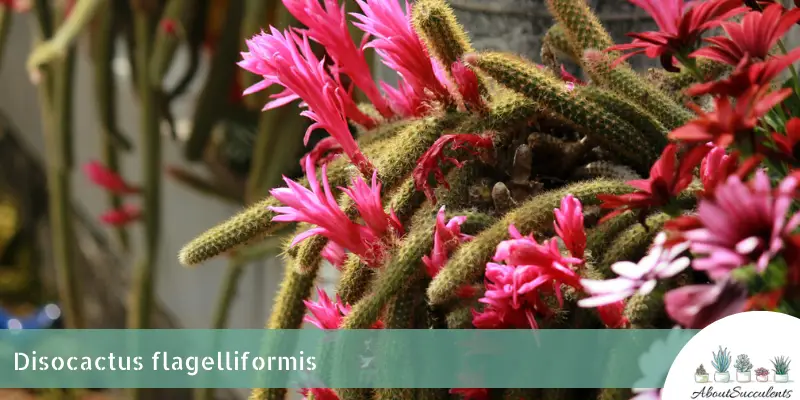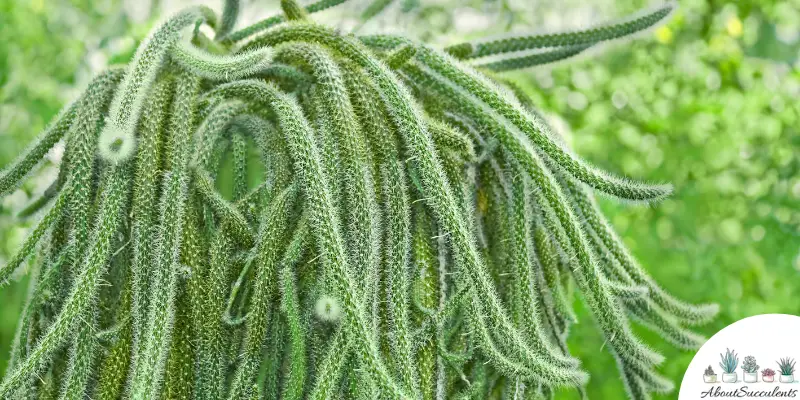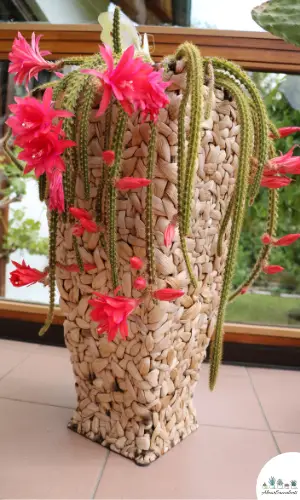
Disocactus Flagelliformis is an entrancing succulent that will certainly compel guests to take selfies because of its long, thick, fuzzy-looking stems which can trail 1m (3’3”) long from a hanging basket.
Also known as Rat Tail Cactus, this succulent is categorized as an epiphytic plant because it grows in low soil cracks such as rocky crevasses. Rat Tail Cactus is native to Mexico and as a desert plant, it grows better in warmer climates. It is a member of the Cactaceae family.
The stems start out with the color green but as the succulent plant matures, the color will change to beige.
Horticulturists prefer to plant Disocactus flagelliformis in a container until the stems grow to maximum height. When the stems become too heavy, they will bend, trail downward, and become the perfect hanging basket succulent!
Disocactus flagelliformis rarely produces flowers but if it does, the blooms will have a tubular shape with bright pink colors that are 5.08cm (2”) long. Spring is the usual time for mature Disocactus flagelliformis to bloom flowers.
General Information:
Also known as: Rat Tail Cactus.
Plant Family: Cactaceae
Origin: Native to Mexico – Oaxaca and Hidalgo.
Height: 1m (36”)
Exposure: Full or partial exposure to morning sunlight for 4 to 6 hours.
Water Needs: Give water only when the soil is dry although the frequency of the watering schedule might increase during the fall and spring seasons which are growing months.
Soil Type: Standard potting soil or cactus mix with added grit, perlite, or pumice to improve drainage.
Soil pH: 5.5 to 6.5
How to Grow and Care for Disocactus Flagelliformis

When handling Euphorbia tirucalli, it’s strongly recommended to wear gardening gloves and goggles. Other than the safety measur
Growing Disocactus flagelliformis is easy and you won’t have problems taking care of it.
Follow our simple tips below on giving Rat Tail Cactus sun exposure, water, and which type of pot and soil to use for best results.
Sunlight
As a desert-dwelling native of Mexico, Disocactus Fagelliformis is not resilient to cold temperatures. If the temperature in your region drops below -1.1° C (30° F), it’s highly recommended to grow Rat Tail Cactus in a container that can be moved indoors.
Disocactus flagelliformis is a wonderful addition to an outdoor garden or as a hanging succulent in a patio. You have to make sure that the succulent gets 4 to 6 hours of direct sunlight.
The same holds true if Rat Tail Cactus is grown as a houseplant. The container basket must be in a location that gets 4-6 hours of full sunlight for the succulent to grow to optimal beauty.
Watering

Disocactus flagelliformis requirements for water are the same as with other succulent plants. The important thing to keep in mind is to only give the plant water when you are 100% sure that the soil is dry.
You can insert a stick 2-5cm (1-2”) into the soil. If the stick feels dry after you pull it out, the succulent will successfully receive the water.
Give the soil a thorough soaking. Excess water must be coming out through the drain hole to be sure that the soil has been drenched.
For succulent plants, it’s better to give Rat Tail Cactus less water than to give it more than it needs. Overwatering the soil leads to root rot which will cut short the life of your succulent.
Another reminder is to give Disocactus Flagelliformis more water during the Fall and Spring seasons which are the growing months. The watering schedule will be less frequent during winter because the soil will remain moist longer.
Pot and Soil
The choice of pot is important for Disocactus flagelliformis because it looks at its marvelous best as a hanging succulent.
Take advantage of its unique appearance by being more daring and choosing an unusual-looking container such as hollow cow’s horn. The drain hole with a mesh net cover at the bottom is important to allow excess water to pass through.
Disocactus Flagelliformis will grow best when planted in standard potting soil or cactus mix with added grit, perlite, or pumice for improved drainage.
How to Propagate Disocactus Flagelliformis
Euphorbia tirucalli is easy to propagate with the use of its stems. Keep in mind that you’ll be cutting the stem. Always wear gloves and goggles when propagating the succulent to keep the milky sap from coming in contact with your skin, eyes, and m
Properly grown Disocactus flagelliformis will feature long, trailing stems covered with dense fuzz that will make your patio look like a set from Star Trek.
If you love this look, you can propagate more Rat Tail Cactus with 2 methods: Cuttings or Seeds.
Method 1: Cuttings
Step 1: Cut off 15cm (6”) from the tip or part of a healthy stem. Use a sterilized and sharpened pair of garden scissors.
Step 2: Allow the stem cuttings to develop calluses over 2 to 3 days. Keep the cuttings in a warm and dry area,
Step 3: Plant the cuttings in well-draining soil with the bottom end down. Keep it lightly moist until the roots take firm hold. This is a fast-growing plant and you can see rooting take place in a few weeks.
Step 4: Water the soil when it’s 100% dry.
Method 2: Seeds
Step 1: Sow the seeds in well-draining soil.
Step 2: Lightly moisten the soil and move it to a location where it can receive partial sunlight.
Step 3: Cover the soil with plastic wrap to start the germination process.
Step 4: When the roots have taken a firm hold in the soil, remove the plastic wrap and give the plant water only when the soil is completely dry.
Frequently Asked Questions
Is Disocactus Flagelliformis Toxic to Cats and Dogs?
Disocactus flagelliformis is not cited as a toxic plant on the website of the American Society for the Prevention of Cruelty to Animals (ASPCA).
This is just a partial list and does not show all the plants that could be toxic to pets. There are studies that have presented findings that Rat Tail Cactus could be dangerous to your cat or dog.
Don’t take chances that your pet falls ill when it comes in contact with this succulent plant. Make sure you keep Disocactus flagelliformis in a location that can’t be reached by pets.
Why Is My Disocactus Flagelliformis Dying?
If you suspect that your Disocactus Flagelliformis is dying, the possible causes are overwatering and pest infestation. To save your beloved succulent, you must act quickly.
Overwatering
A telltale sign of overwatering is if you notice discoloration in the plant’s leaves or stems. You have to act right away and cut off the discolored parts because this means the infection has started and is on its way out.
Your plant probably got infected because its roots rotted away from overwatering. When the roots are immersed in moisture for a long time, the cells burst and they become susceptible to fungal infection.
Get a sterilized knife or garden shears and cut off the discolored parts. Wipe the knife with 70% isopropyl alcohol after every cut. Apply sulfur powder to the wounds on the plant.
Uproot the plant and cut away all of the rotten parts. Let the plant dry out and prepare a new basket with fresh, well-draining soil. Replant Rat Tail Cactus and be very careful when giving the plant water next time.
Pest Infestation
Pests such as mealybugs, aphids, and scale insects are freeloaders that drink away the sap and bring infectious disease on board Disocactus Flagelliformis.
The appearance of white, cotton-like substances on the leaves is proof of the existence of pests. Wipe these substances away with a cotton ball soaked in 70% isopropyl alcohol. Then, spray the plant with neem oil to keep the pests away.
Does Disocactus Flagelliformis Produce Flowers?
Disocactus Flagelliformis rarely produces flowers but when it does, you’ll find tubular-shaped and bright pink blooms in the springtime.
Last Updated on June 9, 2022 by Sofia Lara